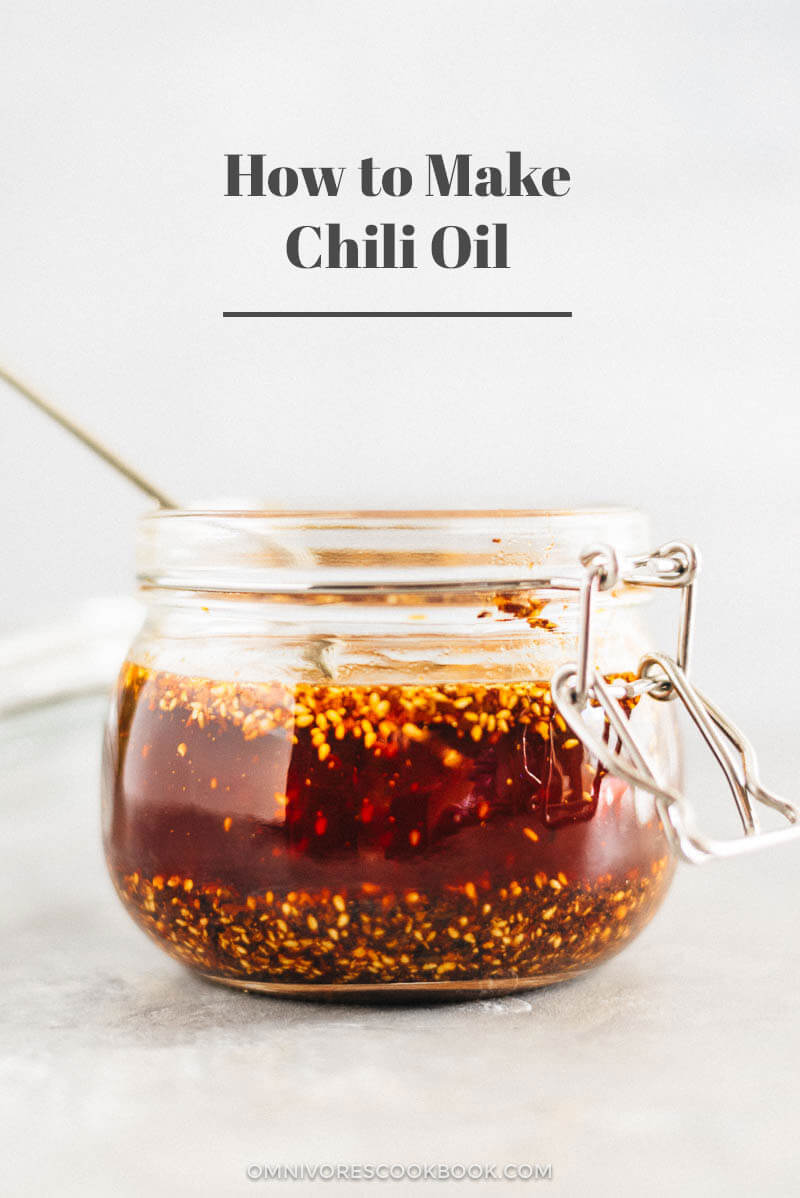
Chili oil is such an important staple for Chinese families, equal to soy sauce and vinegar. For many Chinese people chili oil is as important as ketchup is to American people. It always shows up on tables of small diners, no matter whether it’s a dumplings or noodle place. Once you’re hooked, you’ll want to pour it on everything.
Whenever I’m talking about chili oil, I always refer to homemade chili oil. It tastes ten times better than the store bought product, lasts just as long if you store it in the fridge, and does not contain additives or MSG. There is this fresh aromatic nuttiness that bottled chili oil never delivers.
Plus, when you use chili oil like a Chinese person, you gotta mix in the chili flakes as well. The chili flakes are well toasted when you cook the chili oil, so they taste less spicy but quite smoky with a crispy texture. When mixing with noodles, these tiny umami bits coat the ingredients evenly and each bite releases waves of piquant zing to your taste buds. It’s as exciting as throwing a handful of Pop Rocks in your mouth!
When I cook Vegetable Chow Mein, Lanzhou Beef Noodle soup, and hearty Sesame Noodle Salad, I’ll always spoon a few dollops of chili oil mixed with thick chili flakes onto my finished dish. This one small action will elevate your cooking from mundane to heavenly.
Cooking process
The process might look intimidating at first, but you won’t believe how easy it is once you try it. There are three steps involved.
(1) Combine chili flakes with aromatics of your choice in a heatproof bowl.
A ceramic bowl is my go-to choice. If you plan to use a glass jar, make sure it is heatproof. We will be dealing with hot oil in the next step. Using glassware might cause the glass to shatter and can be very dangerous.
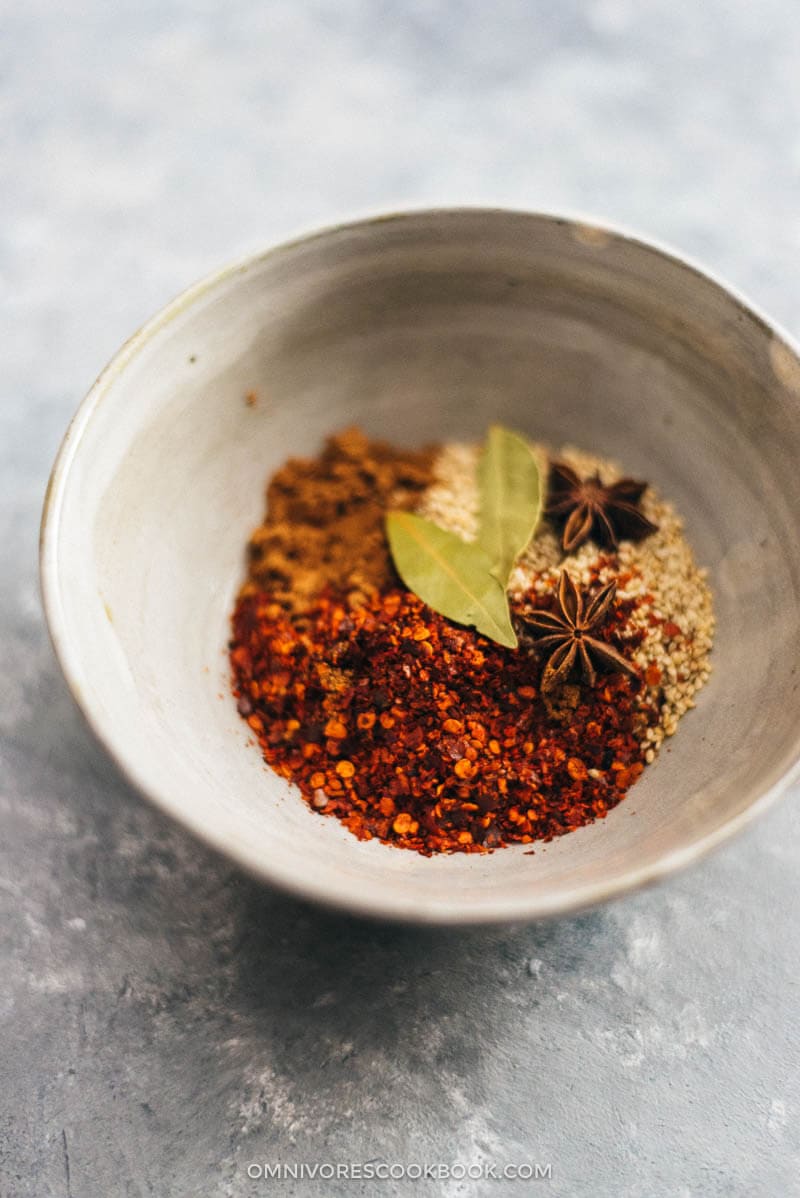
(2) Heat the oil until it reaches 370 degrees F (190 C).
The key to making delicious chili oil is to heat the oil hot enough without overheating it. The hot oil will cook the spices thoroughly and be infused with various flavors. However, if the oil is too hot, it will burn the pepper flakes and sesame seeds, and the resulting chili oil will be bitter in taste.
The best way is to use an instant thermometer to monitor the oil. If you do not have a thermometer, I also introduce a “ginger method” in the recipe below, which is a good indicator of the oil temperature.
Select a small saucepan that has long handle and is good for pouring. Alternatively, you can also use a ladle to transfer the oil.
(3) Pour oil into the bowl with chili flakes.
The oil will bubble fiercely at first and quickly cook the chili flakes. Simply mix everything together with a spoon and let the oil sit until cooled down.
That’s it! Now you have a jar of delicious chili oil to use to create an authentic Chinese flavor.
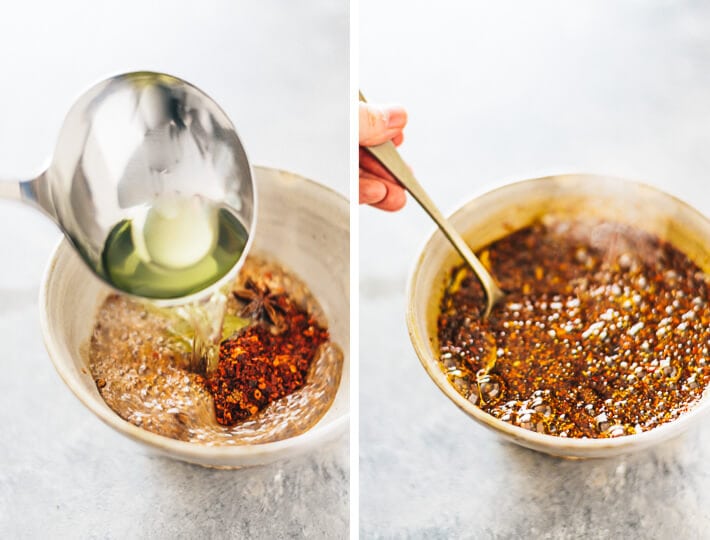
More cooking notes
(1) What types of chili flakes should you use?
The best option is to use fresh chili flakes imported from Sichuan. This type of chili flake is made with premium chili peppers of a vibrant red color. The blend also contains fewer seeds, so your chili oil won’t end up overly spicy.
The next best option is using Korean chili flakes. With these, I found my chili oil doesn’t have the brightest red color, but it doesn’t affect the taste.
(2) How do you make chili flakes?
You can use whole dried chili peppers to make chili flakes too. Lightly toast the peppers in a pan until the pepper turns a bit darker, and grind the peppers into chili flakes. To make sure the oil won’t turn out too spicy, cut open half of the hot peppers with kitchen shears and discard the seeds.
(3) What types of aromatics should you use in the chili oil?
The answer is, you can use many types of aromatics or none at all. The flavor is totally up to personal preference. In China, each region down to each family has their own formula to make their favorite chili oil.
To make the most basic chili oil, you can simply use chili flakes. Some versions use ginger, cinnamon bark, bay leaves, star anise etc.
The recipe below is our family’s formula. We always enjoy adding a few Sichuan peppercorns to add a hint of numbing nuttiness. We also use a pinch of five spice powder to add umami.
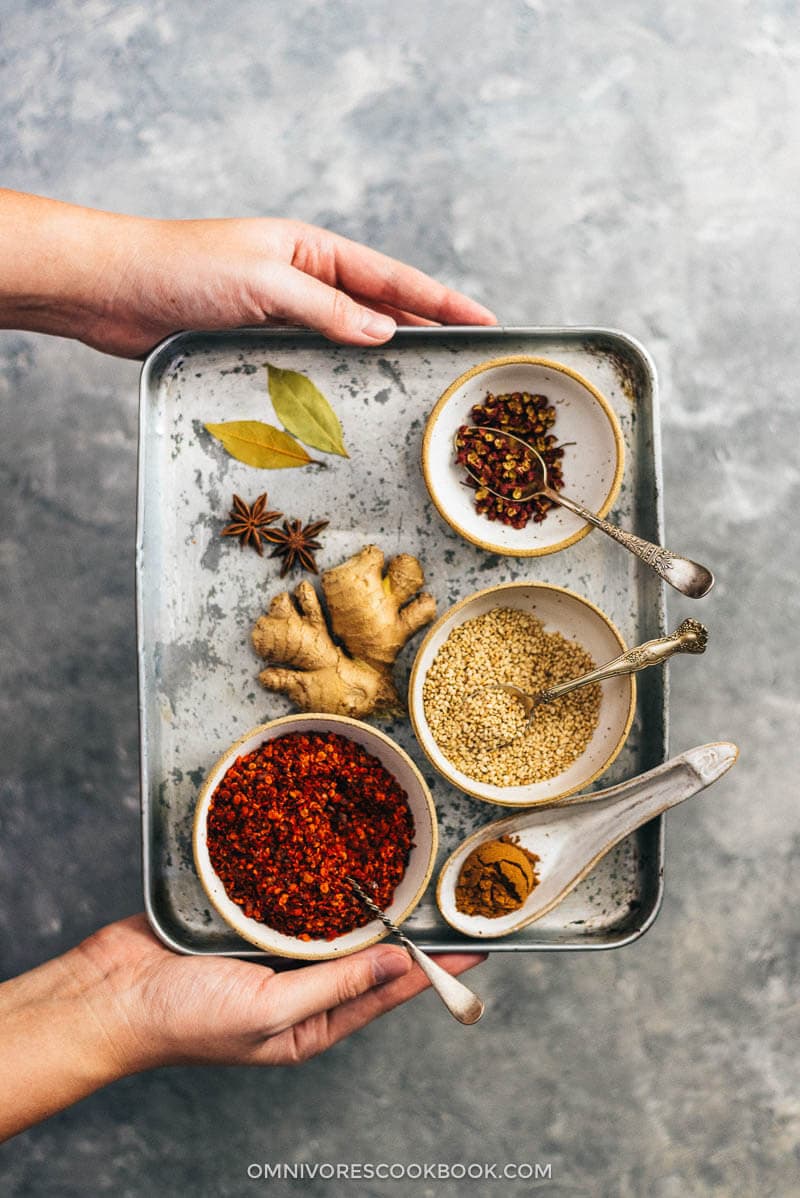
(4) To filter or not to filter the chili flakes?
Once you’ve made the chili oil, you can either filter the oil and discard the chili flakes, or you can leave them in. This habit varies a lot in China depending on the region, so I’d say both methods are authentic and correct.
As a northerner, I grew up having chili oil with tons of chili flakes sitting at the bottom. In fact, in many restaurants you will find the chili oil jar is filled mostly chili flakes and very little oil.
Again, if you choose proper chili flakes (see point #1 above), your chili oil will not be very spicy and it should taste nutty with a balanced umami flavor. The chili flakes should add texture and smokiness to your dish, not spiciness.
How to use chili oil
- Make authentic Sichuan food: Mapo Tofu, Sichuan Spicy Wonton in Red Oil, Sichuan Sliced Beef in Chili Sauce (Fu Qi Fei Pian), Bang Bang Chicken
- Drizzle on soup to make them taste better immediately: Wonton Soup, Instant Pot Chicken Noodle Soup, 15-Minute Curry Ramen with Leftover Ham
- Make a simple cold dish taste irresistible: Real Deal Sesame Noodles, Cucumber Salad
- Use it on congee and oatmeal: 5-Ingredient Savory Oatmeal (Chinese-Style)
- Use it on your roast veggies to add tons of flavor (extremely helpful if you follow a vegetarian or vegan diet)
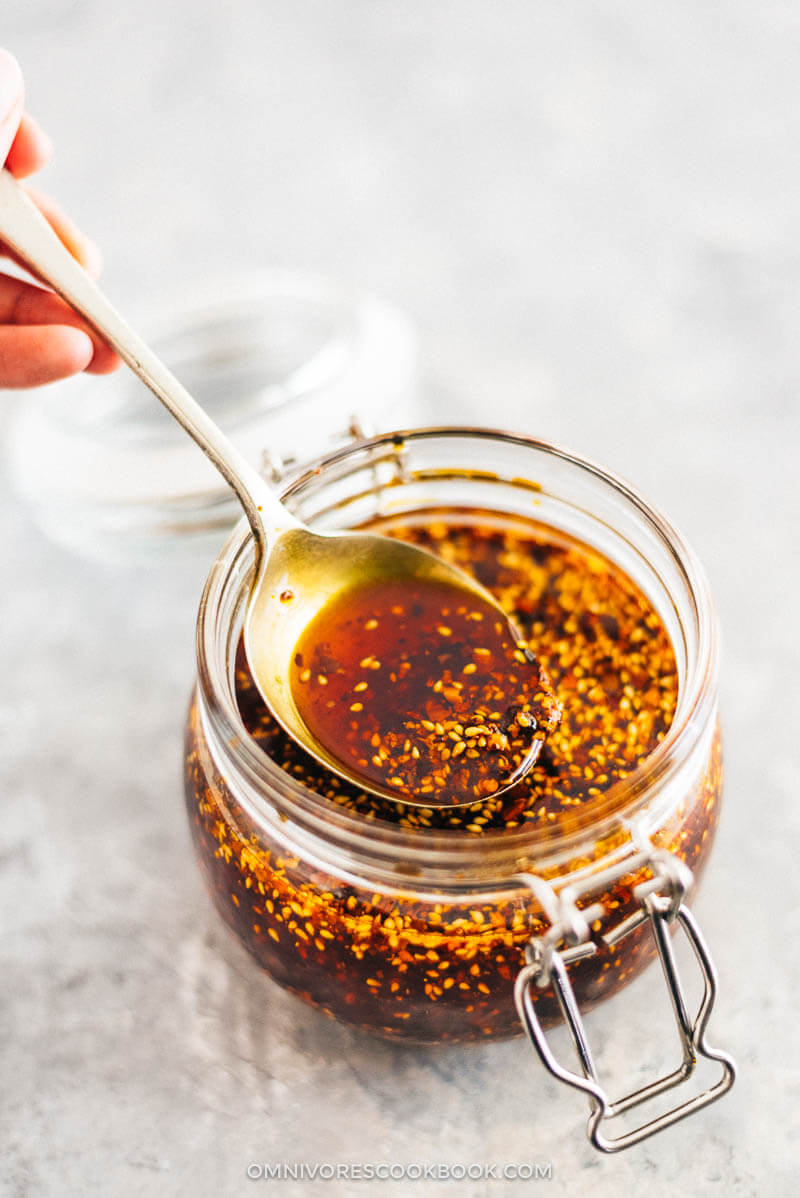
Other homemade Chinese sauces & condiment
- Chinese BBQ Sauce
- Chinese Flavored Sweet Soy Sauce
- Vegetarian Oyster Sauce
- Homemade Black Bean Sauce
If you give this recipe a try, let us know! Leave a comment, rate it (once you’ve tried it), take a picture and tag it @omnivorescookbook on Instagram! I’d love to see what you come up with.
Chinese Cooking Made Easy
Are you new to this website? This free email series is a great place to start. I’ll walk you through a few of my most popular recipes and show you how and why they work. You’ll quickly start to cook better Chinese food in your own kitchen.
Watch video
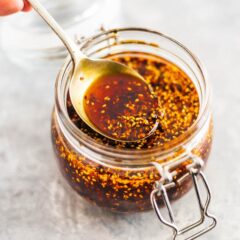
How to Make Chili Oil (辣椒油)
Ingredients
- 4 tablespoons Chinese chili flakes (*footnote 1)
- 2 teaspoons five spice powder
- 3 tablespoons toasted sesame seeds
- 1 teaspoon ground Sichuan peppercorn
- 1 whole star anise (Optional)
- 2 bay leaves
- 1 cup vegetable oil (or grapeseed oil)
- 1 piece thinly sliced ginger (Optional)
Instructions
- Combine chili flakes, five spice powder, sesame seeds, star anise, Sichuan peppercorns, and bay leaves in a heatproof ceramic bowl that can hold at least 2 cups liquid. Place the bowl on a heat resistant coaster.
- Heat oil in a wok (or a skillet) over medium-high heat. Add ginger. When the ginger starts to wither and turns golden brown, immediately turn off the heat. The oil should reach 370 degrees F (190 C) and no higher than 400 F (200 C) if read with an instant thermometer.
- Carefully pour oil or use a ladle to transfer oil into the bowl of mixed spices. The oil will bubble for a few seconds and cook the spices. While the the oil is bubbling, use a metal spoon to stir gently to mix the spices, so they’ll cook thoroughly.
- When the oil cools down a bit, scoop out and discard the star anise and bay leaf.
- The oil is now ready to use! Its flavor will mature if you let it rest for a day, allowing the spices to infuse into the oil.
- The oil can be stored covered at room temperature for two weeks, or up to six months in the fridge in an airtight container.
Notes
Nutrition

Did you make this recipe?
I’d love to hear how it turned out for you! Please take a moment to leave a 5-star rating ⭐️ and share your thoughts in the comments further down the page. It really helps others discover the recipe too.
The recipe was originally published on August 7, 2014, and updated on April 23, 2017.

Barbara
I’m confused about the chili flakes. Maybe I’m just ignorant of the available varieties of chili flakes. I think I’m also hampered by living in Japan. The only chili flakes I’ve seen are simply called red chili flakes without any indication of the type of chili in the bottle. Can you direct me to a Japanese source, or a site where I can get more info? I don’t know what to buy for this essential ingredient. Thank you. I’m a much better cook because of you.
Maggie Zhu
Hi Barbara, the chili flake is a blend of ground up chili peppers that have different hot levels.
The ground is coarse than the chili powder, but it’s OK to use the find ground as well.
The product from the Mala Market is the best: https://themalamarket.com/products/sichuan-chili-flakes-xiang-la-jiao-mian?aff=2 (Not sure if they’re offering international shipping right now but it’s a great resource to learn about the product)
The chili pepper you showed in the other comment is one of the chilis that’s used in this blend. If that’s the only dried chili pepper you can find, you can use a food processor or blender to grind it, then use the grind as the chili flakes. The only tricky part is to decide how much seeds you want to include, because the seeds are the most spicy. If not sure, I recommend removing half or most of the seeds, so the oil won’t get too spicy.
Barbara
Thanks! I needed a little reassurance on this point.
Wendy
Amazing! I find myself adding it to everything. My parents gifted a load of chilis, which I dried and used whole out of sheer laziness. Just perfect.
Mary
Mmmmmm. Yeah. That’s good! Thank you!
Nancy Ng
I love this recipe! Simple and easy to follow.
Tania
Hi I think my oil wasn’t hot enough as when I poured it the chilli flakes didn’t foam… have I ruined my chilli oil?
Maggie Zhu
Hi Tania, the oil has to be hot enough to release the flavor from the chili flakes. What you can do is to return everything into a small sauce pan, heat over medium low heat while whisking to slowly bring the oil to a simmer. Use very gentle low heat to cook it for 3 to 4 minutes, until the chili flakes just turn slightly darker and the oil is orange / red. Then you can let it chill completely before using it.
Philip
I can’t wait to try this recipe for chili oil. Unfortunately, I think the ground chili’s you recommend at Mala Market would be too spicy for me (do you know what number on the Scoville scale these might be?) The description says it’s a mixture of mild, moderate, and hot flakes but this link https://themalamarket.com/collections/all/products/er-jing-tiao-chili is more mild so I may try that first.. your thoughts?
Maggie Zhu
I think you can totally buy milder peppers and ground them to make your own blend. The Er jing tiao chili would be nice since it’s milder.
PS. the chili pepper flake blend from the mala market is actually not that spicy if you make them into chili oil. It does contain some hot pepper flakes but I never found it overwhelmingly spicy. Of course you can make your own blend just to be safe 🙂
Philip
Thanks Maggie. I made the oil with some Korean chili flakes I had on hand and it wasn’t too spicy but I did purchase the ones you recommended from the Mala Market. I also bought their Sichuan peppercorns and will make the chili oil again when this batch is gone. 😍
Les
This oil is a hit with everyone. It is so much better than the old stuff on the tables in restaurants it stuns people when they try it!
SCislander
This is a wonderful and easy recipe. I make extra for family members, who love it.
Melissa
I’ve made this chili oil a couple times in the past week and I absolutely love it. Unfortunately, I did not use Sichuan seeds since I don’t have it in on hand, but the result still has the nutty, smoky taste that I crave! I can’t wait to try this recipe with real Sichuan peppers. I also used avocado oil and black sesame seeds, since that’s what I had on hand.
I find this recipe more approachable than some recipes since it calls for using a five spice mix. As a result, I was able to try making chili oil at home for the first time and it was so worth it! Thank you for sharing.
Chet Kastava
I just discovered your site and I love it. Thanks. I have a cooking chili oil problem. Would it be possible to place the ingredients in a pot with the oil and cook at 225? I’m not comfortable with cooking with oil at 375 or 400. I can remove the bay leaves and star anise after it cools. Thanks
Maggie Zhu
I have another recipe that cooks the oil in the pan: https://omnivorescookbook.com/biang-biang-noodles
The formula is different but the result is great.
Peter Buckley
A very fine recipe. We always have some in the fridge and make some fresh monthly. We use very good quality canola oil and are exact about the temperature.
Esther
Hello, this is a great recipe! I was wondering I just have canola oil. Would this work?
Maggie Zhu
Yes canola oil will work. Happy cooking!
Deborah
This is a great recipe. It’s very easy, just takes a bit of time to gather the various components beforehand. We used to buy chili oil in China but since we’ve gone to NZ, it’s hard to find good oil without preservative. Now I make this and it’s great with our noodle soup.
Uncle Gary
This is a great recipe, thank you! How would I go about making this spicier? My family loves it however adding more chili flakes did not make it spicier as I would have expected. Is there another ingredient I can add to increase the heat? Thanks.
Maggie Zhu
You should use a different type of chili such as a bit cayenne powder if you want to increase the heat.
Keirstin
Hi I was just wondering if could just use red pepper flakes instead because I dint want to buy Chinese chili flakes and Sichuan pepper corns. Which is more important?
Maggie Zhu
It’s totally OK to replace the Chinese chili flakes with red pepper flakes as long as your blend is not super spicy. Chinese chili flakes are usually medium spicy so the chili oil will end up fragrant but not too hot.
The Sichuan peppercorns is not spicy at all, but has a numbing tingling taste when chew on it. It will add a different dimension of aroma to the oil, so it’s not replaceable by other spices. That being said, you can always skip it (many chili oil brands do not include it I think), but I really like its taste.
Lily
I put off trying this recipe for such a long time out of…laziness, probably, but I finally made it a couple of weeks ago and I can’t believe it took me so long. I put it on eeeeeeverything, it’s SO delicious!
Hailey
The first time I made this, I thought, I should give some to a friend. How will I go through so much spicy oil before it starts to go bad?
I had to make a new batch three weeks later, because we started putting it on everything! Soups, eggs, meat, fish… it’s great on plain white rice if you’re in the mood for a quick snack. I have to make it every two weeks now. We go through a lot of it.
Gary Peterson
Hi Maggie,
Chili oil is really good. Tried it in Cucumber Salad, in ramen and in Miso soup, goes well with everything.
Gary
Bluesman
370 degrees F is *way* too hot for the oil. I used a thermometer to make sure I got the temp right and the spices and chili flakes burned immediately. Most recipes I’ve looked up use a temp of no more than 250 degrres F.
Rand
Thank you for this excellent recipe Maggie! We made this yesterday to serve with dan dan noodles and it was exactly as you said. We left out the optional ingredients except for the garlic and it was perfect!